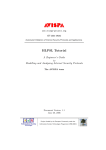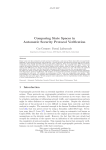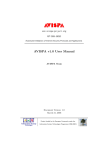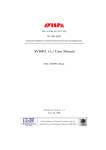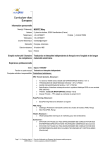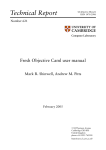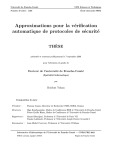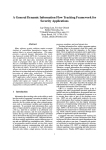Download User Manual
Transcript
INRIA/IRISA LANDE Project a Security Protocol ANimator for AVISPA Version 1.5 User Manual September 2008 Yann GLOUCHE, Thomas GENET and Erwan HOUSSAY, IRISA/Universit´e de Rennes 1 SPAN: a Security Protocol ANimator for AVISPA c Yann GLOUCHE, Thomas GENET and Erwan HOUSSAY, 2006-2008 Copyright SPAN uses the following libraries: c Laurent Vigneron, 2005 • HLPSL2IF c Mathieu Turuani, 2005 • Matching modulo exp and xor, part of CL-ATSE Contents 1 SPAN overview 1.1 What is AVISPA ? . . . . . . . . . . . . . . . . . . . . . . . . . . . . . . . . . . . . . . 1.2 Availability, License and Installation . . . . . . . . . . . . . . . . . . . . . . . . . . . . 1.3 Bug report and information . . . . . . . . . . . . . . . . . . . . . . . . . . . . . . . . . 1 1 2 3 2 Installation 3 3 Specification Language 3 4 SPAN reference manual 4.1 Local Graphical User Interface for AVISPA . 4.2 Basic Protocol Animation . . . . . . . . . . . 4.3 Variables Monitoring . . . . . . . . . . . . . . 4.4 The intruder simulation . . . . . . . . . . . . 4.4.1 Description . . . . . . . . . . . . . . . 4.4.2 How to use it? . . . . . . . . . . . . . 4.5 The attack simulation . . . . . . . . . . . . . 4.5.1 Description . . . . . . . . . . . . . . . 4.5.2 Example of use . . . . . . . . . . . . . 4.6 Load/Save, Print/Export and Specific display Figure list . . . . . . . . . . . . . . . . . . . . . . . . . . . . . . . . . . . . modes . . . . . . . . . . . . . . . . . . . . . . . . . . . . . . . . . . . . . . . . . . . . . . . . . . . . . . . . . . . . . . . . . . . . . . . . . . . . . . . . . . . . . . . . . . . . . . . . . . . . . . . . . . . . . . . . . . . . . . . . . . . . . . . . . . . . . . . . . . . . . . . . . . . . . . . . . . . . . . . . . . . . . . . . . . . . . . . . . . . . . . . . . . . . . . 4 4 4 5 6 7 8 10 10 11 11 11 SPAN: a Protocol Animator for AVISPA 1 Page 1 SPAN overview 1.1 What is AVISPA ? Avispa [ABB+ 05, avi] is now a commonly used verification tool for cryptographic protocols. The main advantage of this tool is the ability to use different verification techniques on the same protocol specification. The protocol designer interacts with the tool by specifying a security problem (ie a protocol paired with a security property that the protocol is expected to achieve) in the High-Level Protocol Specification Language (HLPSL for short [Ohe05]). The HLPSL is an expressive, modular, role-based, formal language that is used to specify control-flow patterns, data-structures, alternative intruder models and complex security properties, as well as different cryptographic primitives and their algebraic properties. These features make HLPSL well suited for specifying modern, industrial-scale protocols. HLP SL OF M C +3 SP AN it IF WNNWNWWWW i i i NNN WWWWWWW iiii tttt NNNN WWWWWW iiii tttttttt i i i t WWWW '/ N #+ u} tttt px iii CL SAT M C T A4SP Figure 1: AVISPA system architecture and SPAN Then, the HLPSL specification is translated into an Intermediate Format (IF) which is used by the various verification tools embedded in AVISPA: OFMC the On-the-Fly Model-Checker [BMV05], CL Constraint-Logic-based model-checker [Tur06], SATMC SAT-based Model-Checker [AC05], and TA4SP Tree Automata based Automatic Approximations for the Analysis of Security Protocols [BHK04]. The role of SPAN is to symbolically execute a HLPSL protocol specification. This turns out to be useful, when writing HLPSL, so as to have a better understanding of the specification, check that it is executable and that it corresponds to what is expected. Figure 1 depicts the overall architecture of the system including SPAN. The initial development of the SPAN tool was done in collaboration with Olivier Heen and Olivier Courtay of Thomson R&D France [GGHC06]. Since HLPSL is a far more expressive language than basic ”Alice & Bob” notation, writing an HLPSL specification is still not an easy task. In HLPSL, protocols are defined role by role rather than message by message like it is done using ”Alice & Bob” notation. As a result, HLPSL specifications are far less ambiguous but more difficult to read. Thus, it is sometimes difficult for the protocol designers to figure out if the HLPSL specification they wrote corresponds to the ”Alice & Bob” protocol they had in mind. SPAN helps in interactively producing Message Sequence Charts [HT03] (MSC for short) which can be seen as an ”Alice & Bob” trace from an HLPSL specification. SPAN can represent one or more sessions of the protocol in parallel according to the informations given in the role environment. Then, MSCs are produced interactively with the user. SPAN also includes the possibility to check the values, at every moment, of the variables of each principals: the user chooses the variables of each roles he wants to monitor. The three modes of SPAN are • Protocol Simulation for simulating the protocol and build a particular MSC corresponding to the HLPSL specification; SPAN: a Protocol Animator for AVISPA Page 2 Figure 2: Local version of the AVISPA web interface • Intruder Simulation for simulating the protocol with an active/passive intruder; • Attack Simulation for automatic building of MSC attacks from the output of either OFMC or CL-ATSE tools. When an intruder is under concern, after each step of protocol execution, SPAN shows the current intruder knowledge and proposes to construct and send malicious messages from this knowledge. Message patterns are proposed to the user conjointly with intruder data, relevant w.r.t. pattern structure and type. The tool can save and load execution traces corresponding to the execution of the protocol supervised by the user. The MSC can be exported in postscript format or PDF format. Finally, as shown in Figure 2, SPAN comes with a local version of the web interface of AVISPA that supports the editing of protocol specifications, allows the user to select and configure the back-ends integrated into the tool and launch the three different kind of animations: protocol simulation (with no intruder), intruder simulation (build your own attacks by hand), attack simulation (load attacks found by OFMC/CL-ATSE in the simulation). 1.2 Availability, License and Installation SPAN is freely available, under the terms of the GNU LIBRARY GENERAL PUBLIC LICENSE. SPAN: a Protocol Animator for AVISPA 1.3 Page 3 Bug report and information Please report comments and bugs to [email protected]. 2 Installation SPAN is developped in OCaml. The Tcl/Tk library version 8.4 (for Linux and MacOS) and version 8.3 (Windows) is necessary to use this application. See README.txt file of the distribution for details about installation of binary versions and for compilation of source versions. 3 Specification Language The HLPSL is an expressive, modular, role-based, formal language that is used to specify controlflow patterns, data-structures, alternative intruder models and complex security properties, as well as different cryptographic primitives and their algebraic properties. We give a flavour of HLPSL using the specification of the Needham-Schroeder Public Key protocol [NS78]: 1. A ,→ B : {NA , A}KB 2. B ,→ A : {NA , NB }KA 3. A ,→ B : {NB }KB HLPSL specifications are based on role descriptions, i.e. finite state automata, where transitions are fired when a message is sent or received. With regards to ”Alice & Bob” notation, HLPSL makes internal state of roles, nounce generation, message sending and reception explicit. Here is an example of a basic role decalaration extracted from the HLPSL specification of this protocol. role alice (A, B: agent, Ka, Kb: public_key, SND, RCV: channel (dy)) played_by A def= local State : nat, Na, Nb: text init State := 0 transition 0. State = 0 /\ RCV(start) =|> State’:= 2 /\ Na’ := new() /\ SND({Na’.A}_Kb) 2. State = 2 /\ RCV({Na.Nb’}_Ka) =|> State’:= 4 /\ SND({Nb’}_Kb) end role role bob(A, B: agent, Ka, Kb: public_key, SND, RCV: channel (dy)) played_by B def= local State : nat, Na, Nb: text init State := 1 transition 1. State = 1 /\ RCV({Na’.A}_Kb) =|> State’:= 3 /\ Nb’ := new() /\ SND({Na’.Nb’}_Ka) 3. State = 3 /\ RCV({Nb}_Kb) =|> State’:= 5 end role Then, roles are composed together in sessions where the knowledge shared between the roles (public keys for instance) are made explicit. SPAN: a Protocol Animator for AVISPA Page 4 role session(A, B: agent, Ka, Kb: public_key) def= local SA, RA, SB, RB: channel (dy) composition alice(A,B,Ka,Kb,SA,RA) /\ bob(A,B,Ka,Kb,SB,RB) end role Finally, the environment used for protocol execution is defined, where ’i’ denotes the intruder. The environment also defines the initial knowledge of the intruder and the initial setting for the sessions, i.e. how many sessions are runned and who run them. role environment() def= const a, b, c, d : agent, ka, kb, ki, kc, kd : public_key, intruder_knowledge = {a, b, ka, kb, kc, kd, ki, inv(ki)} composition session(a,b,ka,kb) /\ session(c,d,kc,kd) /\ session(a,i,ka,ki) end role In the example above, four honnest agents are defined, namely a,b,c, and d, and the intruder knows all the public keys as well as its own private key inv(ki). For more details about HLPSL refer to [avi, Ohe05]. 4 4.1 SPAN reference manual Local Graphical User Interface for AVISPA As shown in figure 3, SPAN comes with a local version of the web graphical interface of AVISPA. It looks the same and provides the same features: simple editing of protocol specifications, selection and configuration of the AVISPA verification back-ends and two buttons (those ones are new): Protocol simulation (honnest agents alone), Intruder simulation (honnest agents and an intruder) and Attack simulation (same layout as Intruder simulation but attacks are automatically built using OFMC/CLATSE). 4.2 Basic Protocol Animation Starting from such an HLPSL specification, such as the one given in Section 3, SPAN helps to build one possible MSC corresponding to that specification. SPAN can represent one or more sessions of the protocol in parallel according to the informations given in the role environment. Then, MSCs are produced interactively with the user. At every moment, SPAN proposes to the user to choose between all the transitions for which a message can be sent by a principal and received by another. This approach makes it possible to resolve interactively all the choices that may arise during the construction of MSC (Non-deterministic protocols, choices between two transitions to trigger in two different sessions etc...). The execution of a protocol’s transition generally adds a transition on the MSC. Figure 4 shows a partial execution of a protocol where the frame Incoming events contains all the transitions that can be currently fired (by double click), and the frame Past events contains the list of all transitions already fired. SPAN: a Protocol Animator for AVISPA Page 5 Figure 3: Details of the general verification graphical interface 4.3 Variables Monitoring SPAN also includes the possibility to check the values, at every moment, of the variables of each principals: the user chooses the variables of each roles he wants to monitor. It is possible to control the values of variables. In the item menu ”Variables Monitoring”, the user chooses the role for which he wants to control the variables. Then, among all the variables of a given role, he can choose the variables to monitor (See Figure 5(a)). Finally, the user can double click on the rectangular click zones displayed in the MSC in order to display the values at a given step. SPAN: a Protocol Animator for AVISPA Page 6 Figure 4: The SPAN animator interface during an interactive execution (a) Variables selection (b) Content of variables displayed in the MSC Figure 5: Variables monitoring 4.4 The intruder simulation In this section we describe the intruder simulation interface. The purpose of this interface is to provide a way to build by hand attacks over protocols. Indeed, the automatic verification tools always end up with the smallest attack that can be found on a protocol. Note that the attacks found by OFMC/CLATSE can be automatically loaded as MSC in the intruder simulation interface, see section 4.5. However, it is sometimes useful to represent or to try other attacks. This is the purpose of the manual SPAN: a Protocol Animator for AVISPA Page 7 intruder simulation interface we know present. 4.4.1 Description It is possible to simulate an intruder who can receive all messages, store them in its knowledge, decrypt information if he has the key, build new messages and send them to any other agent. In HLPSL, the intruder is named i, and his initial knowledge is explicitely defined in the specification (intruder knowledge = {...}). After each step of the protocol execution, when the intruder receives a message, he can automatically deduce a new knowledge from its current knowledge and this new message (see Figure 6). For example, if intruder knowledge = {{m} k} where m is a message and k is a symmetric-key (resp. a public key) then, if the intruder receives k (resp. inv(k)) then he is abble to deduce and store m. In that case, his knowledge becomes intruder knowledge = {{m} k, k, m}. In the same way, when the intruder receives a tuple a.b.c, then he automatically deduces a, b, and c. Figure 6: Simulation with the intruder Using a specific interface (see Figure 7), SPAN can also compose terms of the intruder’s knowledge to generate a new message. In this interface, message patterns and potential receivers are proposed to the user conjointly with intruder data that fit in the pattern holes. In Figure 7, we can see that the upper part of the interface proposes relevant message patterns (messages that are likely to be received by the other principals in the current protocol step). Once a pattern is selected, in the lower part of the interface, the user can select relevant informations to fill the gaps (relevant w.r.t. type, message structure and intruder knowledge). This permits to quickly reconstruct the MSC of a known attack SPAN: a Protocol Animator for AVISPA Page 8 on a protocol or, with a little expertise, to find new ones. Figure 7: Intruder message construction interface 4.4.2 How to use it? Recall the protocol given in Section 3. Here are the basic data of the protocol: • KA and KB are two publics keys • inv(KA ) and inv(KB ) are two privates keys • NA and NB are nonces The initial knowledge of the intruder contains all the public keys as well as its own public and private key (see Figure 8). The protocol can be attacked if Alice wants to start a protocol session with the intruder. Alice starts the protocol with the Intruder and thus use its public key, KI , to cipher the message: A ,→ I : {NA , A}KI This first step can be simulated in SPAN (see Figure 9). SPAN: a Protocol Animator for AVISPA Page 9 Figure 8: The initial intruder’s knowledge Figure 9: Alice starts the protocol with the intruder instead of Bob Then the intruder I can decrypt {NA , A}KI with inv(KI ), thus he automatically deduces NA and A (see Figure 10, where in the current session the value of the nonce NA is nonce-1). Since KB is also known by the intruder, using the message construction interface, the user can build the message {NA , A}KB whose value in the current session is {nonce-1.a} {kb} (see Figure 10). I(A) ,→ B : {NA , A}KB The intruder I sends {NA , A}KB to Bob (B). Thus, Bob thinks that the message comes from Alice though it comes from the intruder. Then, Bob continues to execute the protocol with A using the nonce NA that A has created for initiating a communication with the intruder. Alices continues to execute the protocol with the intruder (see Figure 12). SPAN: a Protocol Animator for AVISPA Page 10 Figure 10: The intruder compose a message for Bob Thus, we can build the original attack found by G.Lowe [Low96]: A ,→ I : {NA , A}KI I(A) ,→ B : {NA , A}KB B ,→ A : {NA , NB }KA A ,→ I : {NB }KI I(A) ,→ B : {NB }KB 4.5 The attack simulation In the previous section we show how to build by hand an attack over a protocol using the intruder simulation interface. However, when the automatic verification tools OFMC/CL-ATSE find the attack of interest this one can be automatically loaded in the intruder simulation interface using the attack simulation button. 4.5.1 Description From version 1.5, SPAN proposes a new button for automatically building MSC from the output of OFMC and CL-ATSE verification tools. Once an HLPSL specification is loaded in the interface, select either OFMC or ATSE verification tools then click on the attack simulation button. SPAN is then running the selected verification tool, get its output and if an attack is found then it is loaded in the intruder simulation interface. Note that both verification with OFMC/CL-ATSE and loading in the intruder simulation interface may take some time. SPAN: a Protocol Animator for AVISPA Page 11 Figure 11: Bob receives a message from the intruder instead of Alice Once the MSC of the attack has been built in the intruder simulation interface you can play with it, go backward/forward, see intruder’s knowledge, monitor variables and also save it like any other MSC protocol simulation. 4.5.2 Example of use On the protocol given in Section 3, the automatic tools OFMC/CL-ATSE find the same man in the middle attack. It can be automatically built as a MSC by clicking on the attack simulation button, see Figure 13. 4.6 Load/Save, Print/Export and Specific display modes Save/Load For a given protocol, a constructed MSC can be saved, reloaded and replayed in SPAN (See Figure 14). Print/Export The MSCs can be exported in postscript format or PDF format to be printed or integrated in other documents. (See Figure 15) Display mode Using the options of the Modes menu it is possible to display additionnal informations on the MSC: the message pattern of the sender, the message pattern of the receiver, all the message sendings on the network (useful when several messages are sent at once). Each of these elements can be drawn (or not) on the MSC. (See Figure 16) SPAN: a Protocol Animator for AVISPA Page 12 Figure 12: The man in the middle attack continued: the intruder is between Alice and Bob List of Figures 1 2 3 4 5 6 7 8 9 10 11 12 13 14 AVISPA system architecture and SPAN . . . . . . . . . . . . . . . . . . . . . . . . . . Local version of the AVISPA web interface . . . . . . . . . . . . . . . . . . . . . . . . . Details of the general verification graphical interface . . . . . . . . . . . . . . . . . . . The SPAN animator interface during an interactive execution . . . . . . . . . . . . . . Variables monitoring . . . . . . . . . . . . . . . . . . . . . . . . . . . . . . . . . . . . . Simulation with the intruder . . . . . . . . . . . . . . . . . . . . . . . . . . . . . . . . Intruder message construction interface . . . . . . . . . . . . . . . . . . . . . . . . . . The initial intruder’s knowledge . . . . . . . . . . . . . . . . . . . . . . . . . . . . . . . Alice starts the protocol with the intruder instead of Bob . . . . . . . . . . . . . . . . The intruder compose a message for Bob . . . . . . . . . . . . . . . . . . . . . . . . . . Bob receives a message from the intruder instead of Alice . . . . . . . . . . . . . . . . The man in the middle attack continued: the intruder is between Alice and Bob . . . Automatic construction of the MSC for attack over Needham-Shroeder public key protocol Load and save an execution trace of a protocol . . . . . . . . . . . . . . . . . . . . . . 1 2 5 6 6 7 8 9 9 10 11 12 13 14 SPAN: a Protocol Animator for AVISPA Page 13 Figure 13: Automatic construction of the MSC for attack over Needham-Shroeder public key protocol 15 16 Export a MSC . . . . . . . . . . . . . . . . . . . . . . . . . . . . . . . . . . . . . . . . Display modes for messages . . . . . . . . . . . . . . . . . . . . . . . . . . . . . . . . . 14 15 SPAN: a Protocol Animator for AVISPA Page 14 Figure 14: Load and save an execution trace of a protocol Figure 15: Export a MSC References [ABB+ 05] A. Armando, D. Basin, Y. Boichut, Y. Chevalier, L. Compagna, J. Cuellar, P. Hankes Drielsma, P.-C. H´eam, O. Kouchnarenko, J. Mantovani, S. M¨odersheim, D. von Oheimb, M. Rusinowitch, J. Santos Santiago, M. Turuani, L. Vigan`o, and L. Vigneron. The AVISPA Tool for the automated validation of internet security protocols and applications. SPAN: a Protocol Animator for AVISPA Page 15 Figure 16: Display modes for messages In K. Etessami and S. Rajamani, editors, 17th International Conference on Computer Aided Verification, CAV’2005, volume 3576 of Lecture Notes in Computer Science, pages 281–285, Edinburgh, Scotland, 2005. Springer. [AC05] Alessandro Armando and Luca Compagna. An optimized intruder model for sat-based model-checking of security protocols. Electr. Notes Theor. Comput. Sci., 125(1):91–108, 2005. [avi] Avispa [BHK04] Y. Boichut, P.-C. H´eam, and O. Kouchnarenko. Automatic Approximation for the Verification of Cryptographic Protocols. In Proc. AVIS’2004, joint to ETAPS’04, Barcelona (Spain), 2004. [BMV05] David A. Basin, Sebastian M¨odersheim, and Luca Vigan`o. Ofmc: A symbolic model checker for security protocols. Int. J. Inf. Sec., 4(3):181–208, 2005. – a tool for Automated http://www.avispa-project.org. Validation of Internet Security Protocols. [GGHC06] Y. Glouche, T. Genet, O. Heen, and O. Courtay. A Security Protocol Animator Tool for AVISPA. In ARTIST-2 workshop on security of embedded systems, Pisa (Italy), 2006. SPAN: a Protocol Animator for AVISPA Page 16 [HT03] D. Harel and P. S. Thiagarajan. Message sequence charts. UML for Real: Design of Embedded Real-time Systems, 2003. [Low96] G. Lowe. Some New Attacks upon Security Protocols. In 9th Computer Security Foundations Workshop. IEEE Computer Society Press, 1996. [NS78] R. M. Needham and M. D. Schroeder. Using Encryption for Authentication in Large Networks of Computers. CACM, 21(12):993–999, 1978. [Ohe05] D.von Oheimb. Specification language hlpsl developed in the eu project avispa. APPSEM, 2005. [Tur06] Mathieu Turuani. The cl-atse protocol analyser. In Frank Pfenning, editor, RTA, volume 4098 of Lecture Notes in Computer Science, pages 277–286. Springer, 2006. In


















